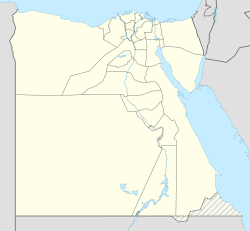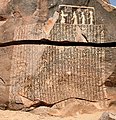geo.wikisort.org - Island
Sehel Island (Ancient Greek: Σῆτις)[1] is located in the Nile, about 2 miles (3.2 km) southwest of Aswan in southern Egypt. It is a large island, and is roughly halfway between the city and the upstream Aswan Low Dam.[2]

Geography
Sehel Island, spanning 3/4 the width of the Nile, is the primary large island below the Nile's First Cataract and the Aswan Low Dam (1902). Following downriver, the next major islands after Sehel are: Saluga, Ambunarti, Elephantine, and then Kitchener's Island. There are a dozen smaller islands scattered around them.
Archaeological artefacts
| sṯt[3] | |||||||
|---|---|---|---|---|---|---|---|
| Era: Old Kingdom (2686–2181 BC) | |||||||
| Egyptian hieroglyphs |
| sṯt(t)[3][4] | ||||
|---|---|---|---|---|
| Egyptian hieroglyphs |
The island was known in ancient tiles as Setet,[5] and there are many archaeological sites, including sacred places, such as the temple of Anuket, the Egyptian water goddess, and goddess of the Nile's cataracts.
Seheil was home to a stone quarry for granite used during various Ancient Egyptian eras, and there are many inscriptions in the island's granite boulders. These inscriptions were usually left by travellers marking either the start or end of their journey to Nubia. There are several famous inscriptions that record ancient historical events. One is the Famine Stela, which is of Greco-Roman origin, but claims to record events from the time of Djoser and Imhotep.
Gallery
- Sehel Inscriptions, in island's granite boulders.
- The Famine Stela, Sehel Island.
References
- "TM Places". www.trismegistos.org. Retrieved 2020-06-22.
- Aswan area map, Planetware.com, web JPEG image: PW: (map shows major islands near Aswan Dam and Aswan High Dam).
- Gauthier, Henri (1928). Dictionnaire des Noms Géographiques Contenus dans les Textes Hiéroglyphiques Vol. 5. pp. 94–95.
- Wallis Budge, E. A. (1920). An Egyptian hieroglyphic dictionary: with an index of English words, king list and geological list with indexes, list of hieroglyphic characters, coptic and semitic alphabets, etc. Vol II. John Murray. p. 1037.
- "Switching..." www.thaliatook.com. Retrieved 2018-02-24.
External links
На других языках
[de] Sehelnarti
Sehelnarti (Sehel ist der eigentliche Name der Insel; narti ist nubisch die Insel[1], altägyptisch Setjet; griechisch Satis) ist der Name einer Nilinsel, die etwa drei Kilometer südwestlich von Assuan und zwei Kilometer südwestlich von Elephantine entfernt liegt. Der Name der Nilinsel leitet sich von einem der dortigen Orte mit der Bezeichnung Sehel ab.- [en] Sehel Island
[fr] Île de Sehel
L'île de Sehel est une île fluviale située sur le Nil, à environ 3,2 km au sud-ouest d'Assouan, une ville du sud de l'Égypte, et qui comporte de nombreux sites archéologiques antiques dont le temple d'Anoukis, la déesse égyptienne de l'eau et des cataractes du Nil.[it] Isola di Sehel
L'Isola di Sehel è un'isola ed un sito archeologico egiziano, a 4 km da Assuan.Другой контент может иметь иную лицензию. Перед использованием материалов сайта WikiSort.org внимательно изучите правила лицензирования конкретных элементов наполнения сайта.
WikiSort.org - проект по пересортировке и дополнению контента Википедии

